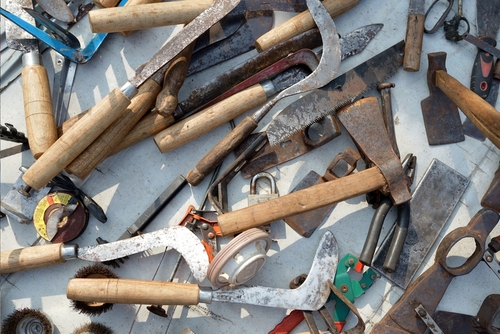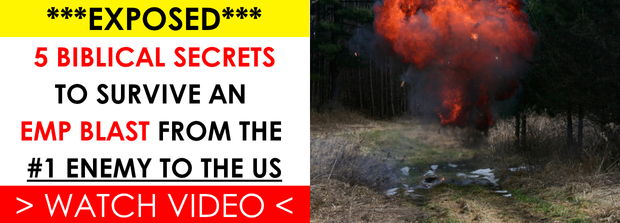When the lights go out for good, the first thing you’ll notice isn’t silence but rather the absence of convenience. The shelves get stripped, the hardware stores empty, and your once-taken-for-granted stash of “extras” starts thinning out. That’s when you realize that necessity is the mother of invention, and what you used to call trash may just become your lifeline.
A bent can or a broken bottle, the things we used to kick down the road suddenly turn into raw survival material. If you’ve got the mindset and a steady hand, you can shape them into tools, weapons, and even food-sourcing materials.
Below, you will find a few suggestions for turning trash into something that can keep you alive when the grid’s gone.
Turning Cans into Fish Hooks
Fish don’t care how shiny your gear looks, and they certainly don’t care about sharpness, strength, and whether the bait moves the way it should. That’s why a simple soda or soup can will become an improvised fishing aid that could put food on your plate when the shelves are bare.
Step 1: Cut the Metal
Take your can and carefully cut out a strip about half an inch wide. If you’ve got a multi-tool with tin snips, you’re in luck. If that’s not the case, you can score it with a knife and bend it until it snaps. Gloves are a must here because one slip is enough to trade dinner for a hand wound.
Step 2: Shape the Hook
Trim the strip into a narrow, tapered piece, then bend it into a hook shape. One end should come to a sharp point, while the other stays flat for tying the line.
Step 3: Make a Barb
Carefully notch a tiny triangle just below the point and bend it outward. That barb keeps the fish from slipping off.
Step 4: Attach to Line
If you’ve got cordage, great. If not, scrap wire or even bottle cord (more on that later) will hold your hook just fine. Tie tight, test the knot, and you’ve got a fishing rig that works.
It won’t win beauty contests, but you’re fishing for survival, not for trophies.
Turning Cans Into Stoves
Fire control is everything during a survival emergency because tasks like cooking, boiling water, and keeping yourself warm depend on how well you manage the flame. A tin can, punctured and cut right, gives you a portable stove that works with twigs, pinecones, or even cardboard scraps.
Step 1: Pick the Can
A coffee can or #10 food can is ideal, but soup cans work just as well. Remember that bigger means better airflow.
Step 2: Cut Air Holes
Drive small holes around the bottom edge for air intake, and then cut a larger hole on the side for feeding fuel.
Step 3: Top Vent
Punch vent holes around the rim where heat escapes to create a steady draft, keeping the fire hot and efficient.
Step 4: Fuel and Burn
Small, dry sticks work best with this improvised stove. Place a pan or pot on top, and you’ve got a hobo stove capable of boiling water in minutes.
Turning Old Tools Into Weapons
When society breaks, the line between tool and weapon blurs fast when deranged individuals roam free. That rusty hammer in the shed, that busted file, even a broken saw blade can be reforged into something that defends as well as it builds.
Step 1: Assess the Steel
Files and saw blades usually hold decent carbon steel, while old hammers and chisels are heavy hitters, perfect for impact.
Step 2: Clean It Up
Rust doesn’t make it useless, but you want the working edge solid. Use a rock, a file, or even sand to grind off the worst of it.
Step 3: Hafting
Wrap the tang or base in cloth, leather, or cordage, then lash it to a strong branch. Suddenly, a file becomes a spearhead. On the other hand, a saw blade segment becomes a wicked chopping edge.
Step 4: Test
Don’t wait until someone’s breaking down your door to see if it holds and test it on wood, brush, or even scrap metal.
You might end up with some ugly weapons, but they are effective and can become lifesavers in a world without 911.
Broken Glass Becomes More Than Just an Improvised Knife
Broken glass is ugly and dangerous, but it’s also ridiculously versatile if you handle it right. Beyond cutting and hafting, shards can become signaling tools, fire starters, perimeter deterrents, and even primitive projectile tips.
Choose the right glass: Look for thick bottle bottoms, headlight glass, or flat window panes. Those give cleaner, stronger edges than thin tableware. Avoid tempered glass from modern vehicle windows — it shatters into pebbles and is harder to shape usefully.
Turning Glass Into A Signal Mirror
Step 1: Select your shard
Look for a flat, reflective piece of glass with a smooth surface. A shard from a broken window, car mirror, or even a smartphone screen can work.
Step 2: Clean and orient
Wipe off dirt or smudges and then hold the reflective side toward the sun, keeping it steady.
Step 3: Angle the flash
Tilt the shard until you see a concentrated flash of sunlight. Direct that flash toward your intended target, whether it’s a rescue plane, a patrol, or a distant group.
Step 4: Practice accuracy
Use your fingers in a “V” to help aim the beam. A quick, repeated flash is more noticeable than a steady one.
A polished shard becomes a surprisingly effective improvised signal mirror, and in clear weather, the flash carries miles. It’s primitive, but reliable when you’ve lost your gear.
Turning Glass Into a Fire-Starting Lens (Limited Use)
Step 1: Find the right shape
You’ll need thick glass with a natural curve, like the bottom of a bottle or a convex shard. Flat pieces won’t concentrate light.
Step 2: Clean and position
Wipe the surface clear of grime and then hold the curved glass between the sun and your tinder bundle.
Step 3: Focus the beam
Move slowly until the sunlight gathers into a tight, bright point. Hold steady until you see smoke rising.
Step 4: Feed the ember
Once the tinder smolders, blow gently and add dry kindling until flame catches.
This trick only works in strong sunlight with the right glass, and keep in mind that it’s not reliable enough to be your main fire-starting method. However, it’s worth knowing for when conditions line up in your favor.
Turning Glass Into Defensive Barriers and Deterrents
Step 1: Choose placement carefully
Find the perimeter you need to protect, like a shallow trench near your shelter or choke point along a path.
Step 2: Set the trap
Embed flat, sharp shards upright, cutting edge exposed, and then angle them so pressure guarantees injury.
Step 3: Conceal the hazard
Cover lightly with leaves, dirt, or debris, and don’t overdo it since the goal is concealment, not durability.
Step 4: Reserve for last resort
This isn’t a toy, and such defenses can injure allies, children, or animals just as easily as intruders. It needs to be deployed only when other deterrents fail.
Broken glass barriers create hesitation, and even if they don’t wound, the threat slows movement and deters trespassers. However, consider the ethical and legal risks before you set them.
Turning Glass Into Arrow and Spear Tips
Step 1: Pick your shard
Select a piece with a long, straight edge and enough thickness to survive impact.
Step 2: Shape the base
Carefully chip one end into a convex or tapered base. Wrap it in cloth, hide, or bark to prevent cutting yourself during handling.
Step 3: Lash securely
Tie the wrapped base tightly to a wooden shaft using cordage, sinew, or paracord. Seal the joint with resin, tar, or pine pitch.
Step 4: Test before hunting
Strike against wood or soft targets to check stability and sharpness. Also, keep in mind to practice safe handling since the glass cuts deep, even when you don’t mean it to.
Properly hafted, a glass point holds a keen edge and penetrates flesh or hide effectively. Keep in mind that primitive cultures used stone, and glass is sharper and easier to shape in a pinch.
Why Modern Add-Ons Still Matter
Trash is the raw material, but a few modern tools make the work safer and faster. A multi-tool with pliers and file, a good pair of gloves and a small sharpening stone are your allies here. None of them takes much room, but they turn trash shaping from a gamble into a system.
Think about it this way: improvisation saves your life when you’ve got nothing. But preparedness makes improvisation faster, safer, and more reliable.
A closing thought
Trash isn’t glamorous because it cuts you, rusts on you, and makes you smell like a dump. However, in a grid-down world, trash becomes survival currency if you know how to use it. Every shard of glass and every bent can become valuable resources if you have the right mindset.
It won’t be easy, and you’ll probably bleed, curse, and wonder why you didn’t stock more gear when you had the chance. But if you’ve got the right attitude, you’ll see what others throw away for what it really is: the bones of survival.



















































































Would have been nice to have PICTURES of your items- makes it 10x easier to imagine & make if we could see the finished product instead of leaving it up to guessing
Smitty, You have that right. Many people are much better learning visually than trying to imagine what the words are trying to convey.
Others are just fine with it, and others actually need to learn by hands on experience, with much difficulty going without. Sometimes it’s hard to “describe” how much pressure to use, etc.etc.,
One simple example, how hard to push a knife blade into the sharpening stone. It took me a while to realize the differences depending on the blade and the stone.
There are more, but this gets the point across.
“When the lights go out for good”?
If/when that does happen, then there won’t BE any established law enforcement……
In dealing with the glass shards as a defense mechanism, you wrote
“ However, consider the ethical and legal risks before you set them.“
Ethics aside, and I concede many of us will still have a conscience, using this type of defense is clearly meant to deter “evildoers” , so I don’t think we should be terribly concerned about them. Either there’s law, or there isn’t. We all have to decide on what we can or want to do to protect our loved ones and ourselves.